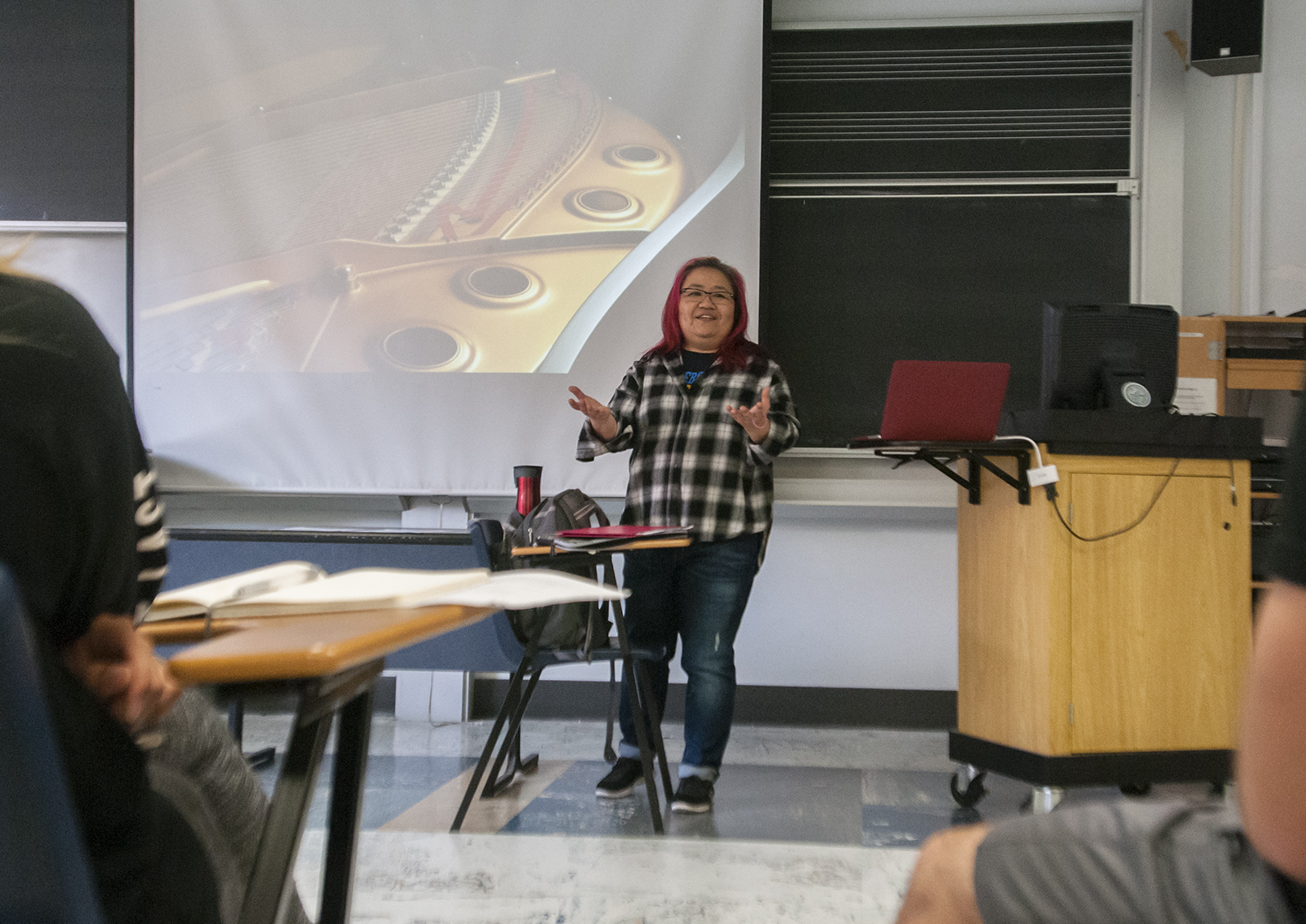Student channels fascination into conducting seminar on Franz Liszt

Fourth-year music history student Beniko Hirosawa-Bates teaches one of 25 spring 2016 Undergraduate Student Initiated Education seminars, “Understanding Franz Liszt, First Rock Star,” which discusses the compositions and life of world-renowned composer and pianist Franz Liszt. (Pinkie Su/Daily Bruin)
By Nina Crosby
June 2, 2016 3:58 a.m.
Beniko Hirosawa-Bates and her son strolled along the cobblestone streets of Hungary, exploring the same roads that 19th-century pianist and composer Franz Liszt walked 150 years prior.
The fourth-year music history student traveled through Budapest, Prague and Vienna in 2005 to be closer to her favorite historical figure. Hirosawa-Bates dreamed of visiting Liszt’s apartment since her early 30s.
“It was totally fangirl stuff,” Hirosawa-Bates said. “I always knew Liszt was a rock star and it always fascinated me.”
Hirosawa-Bates teaches one of the 25 spring 2016 Undergraduate Student Initiated Education seminars at UCLA. USIE allows students with more than 90 units to develop and instruct a lower division seminar under the mentorship of a faculty advisor. In her one-unit seminar Music History 88SA: “Understanding Franz Liszt, First Rock Star,” 12 students discuss the life, music and reputation of Liszt.
Hirosawa-Bates grew up playing the piano and violin, having been introduced to the work of Liszt by her mother. However, her interest in the piano waned as she grew older and the music pieces became more complicated to perform. She returned to classical music in her early 30s, but was more curious about the musicians than their work.
“I started reading up on these composers and became fascinated,” Hirosawa-Bates said. “Their music was great, but the people were so much more interesting.”
Hirosawa-Bates became especially intrigued with Liszt, whose public and personal life has been frequently compared to that of modern rock stars. Liszt believed in “genie oblige,” a conviction that as someone with talent, he had to share it with the public, Hirosawa-Bates said.
Liszt often performed concerts while intoxicated and wearing the same tuxedo from the night before. His reputation as a performer and his fan base are comparable to the Beatles and Elvis Presley, Hirosawa-Bates said.
“He was this public figure who was worshipped and adored, but at the same time, he always struggled with inner aspirations,” Hirosawa-Bates said.
Many stories about the rock star actions of Liszt surfaced through personal correspondence between Liszt’s contemporary composers, Hirosawa-Bates said. He was often involved in disagreements with critics and rivals, which Hirosawa-Bates compared to a modern Twitter war between celebrities.
Hirosawa-Bates said she has read over 2,000 documents, articles and biographies discussing the life and legacy of Liszt. With all of this knowledge, Hirosawa-Bates said she wanted to engage a dialogue about the similarities of past composers and current celebrities with other students on campus.
However, Hirosawa-Bates said as a transfer student and mother, she never had the time to join extracurricular activities or clubs on campus.
Hirosawa-Bates said she noticed a flyer for the USIE program on Bruin Walk and decided to apply. Hirosawa-Bates recognized music history courses didn’t have time to focus on the individual lives of composers. She hoped the program would allow her to educate others on the relevance of Liszt’s public and private lives.
Hirosawa-Bates approached professor Raymond Knapp, chair of musicology, to be her mentor. Hirosawa-Bates first met Knapp through office hours for his course Music History 125D: “Music, History and Culture, 1800 to 1900.”
“Beni was always in the front row, always engaged and bringing her perspective. … She really stood out to me,” Knapp said. “I recognized her passion for Liszt immediately.”
Knapp became Hirosawa-Bates’ mentor through the USIE program, where he helped her establish the course curriculum, manage the syllabus and provide advice on teaching styles.
“She’s very independent and a self-starter,” Knapp said. “She approached me, and it’s rare to have someone so motivated and prepared to take on the responsibilities of the program,” Knapp said.
For Hirosawa-Bates’ spring quarter course, she assigns films, readings and songs that help further the notion of Liszt as a musical icon.
“It’s easy to see Franz Liszt as one of those dead white guys who made beautiful music as a composer,” Hirosawa-Bates said.
Joseph Osborne, a fourth-year music history student, said the class helped him make connections between 19th-century composers and modern celebrity culture. He said focusing on the life of a single composer for an entire quarter was an enlightening experience, since most of his music history classes don’t concentrate on the personal lives of musicians.
Hirosawa-Bates will always be infatuated with Liszt, she said. She hopes to continue forming new connections to contemporary musicians and become even closer to Liszt.
“My husband says I know more about Liszt than I do about him,” Hirosawa-Bates said. “I think he’s right.”


